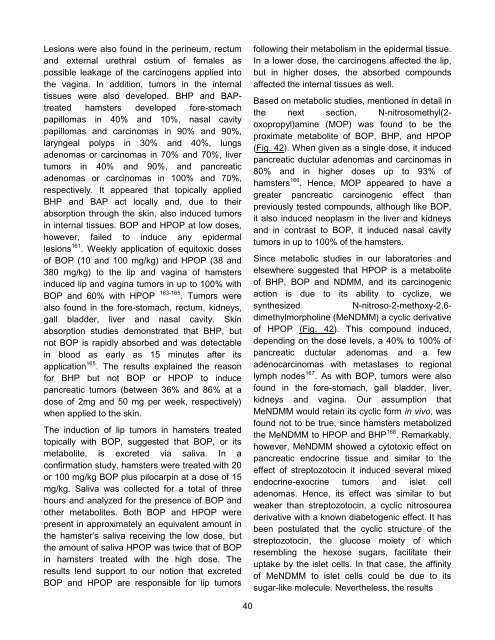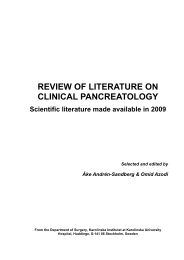Download PDF - The Pancreapedia
Download PDF - The Pancreapedia
Download PDF - The Pancreapedia
You also want an ePaper? Increase the reach of your titles
YUMPU automatically turns print PDFs into web optimized ePapers that Google loves.
Lesions were also found in the perineum, rectum<br />
and external urethral ostium of females as<br />
possible leakage of the carcinogens applied into<br />
the vagina. In addition, tumors in the internal<br />
tissues were also developed. BHP and BAPtreated<br />
hamsters developed fore-stomach<br />
papillomas in 40% and 10%, nasal cavity<br />
papillomas and carcinomas in 90% and 90%,<br />
laryngeal polyps in 30% and 40%, lungs<br />
adenomas or carcinomas in 70% and 70%, liver<br />
tumors in 40% and 90%, and pancreatic<br />
adenomas or carcinomas in 100% and 70%,<br />
respectively. It appeared that topically applied<br />
BHP and BAP act locally and, due to their<br />
absorption through the skin, also induced tumors<br />
in internal tissues. BOP and HPOP at low doses,<br />
however, failed to induce any epidermal<br />
lesions 161 . Weekly application of equitoxic doses<br />
of BOP (10 and 100 mg/kg) and HPOP (38 and<br />
380 mg/kg) to the lip and vagina of hamsters<br />
induced lip and vagina tumors in up to 100% with<br />
BOP and 60% with HPOP 163-165 . Tumors were<br />
also found in the fore-stomach, rectum, kidneys,<br />
gall bladder, liver and nasal cavity. Skin<br />
absorption studies demonstrated that BHP, but<br />
not BOP is rapidly absorbed and was detectable<br />
in blood as early as 15 minutes after its<br />
application 165 . <strong>The</strong> results explained the reason<br />
for BHP but not BOP or HPOP to induce<br />
pancreatic tumors (between 36% and 86% at a<br />
dose of 2mg and 50 mg per week, respectively)<br />
when applied to the skin.<br />
<strong>The</strong> induction of lip tumors in hamsters treated<br />
topically with BOP, suggested that BOP, or its<br />
metabolite, is excreted via saliva. In a<br />
confirmation study, hamsters were treated with 20<br />
or 100 mg/kg BOP plus pilocarpin at a dose of 15<br />
mg/kg. Saliva was collected for a total of three<br />
hours and analyzed for the presence of BOP and<br />
other metabolites. Both BOP and HPOP were<br />
present in approximately an equivalent amount in<br />
the hamster’s saliva receiving the low dose, but<br />
the amount of saliva HPOP was twice that of BOP<br />
in hamsters treated with the high dose. <strong>The</strong><br />
results lend support to our notion that excreted<br />
BOP and HPOP are responsible for lip tumors<br />
40<br />
following their metabolism in the epidermal tissue.<br />
In a lower dose, the carcinogens affected the lip,<br />
but in higher doses, the absorbed compounds<br />
affected the internal tissues as well.<br />
Based on metabolic studies, mentioned in detail in<br />
the next section, N-nitrosomethyl(2oxopropyl)amine<br />
(MOP) was found to be the<br />
proximate metabolite of BOP, BHP, and HPOP<br />
(Fig. 42). When given as a single dose, it induced<br />
pancreatic ductular adenomas and carcinomas in<br />
80% and in higher doses up to 93% of<br />
hamsters 166 . Hence, MOP appeared to have a<br />
greater pancreatic carcinogenic effect than<br />
previously tested compounds, although like BOP,<br />
it also induced neoplasm in the liver and kidneys<br />
and in contrast to BOP, it induced nasal cavity<br />
tumors in up to 100% of the hamsters.<br />
Since metabolic studies in our laboratories and<br />
elsewhere suggested that HPOP is a metabolite<br />
of BHP, BOP and NDMM, and its carcinogenic<br />
action is due to its ability to cyclize, we<br />
synthesized N-nitroso-2-methoxy-2,6dimethylmorpholine<br />
(MeNDMM) a cyclic derivative<br />
of HPOP (Fig. 42). This compound induced,<br />
depending on the dose levels, a 40% to 100% of<br />
pancreatic ductular adenomas and a few<br />
adenocarcinomas with metastases to regional<br />
lymph nodes 167 . As with BOP, tumors were also<br />
found in the fore-stomach, gall bladder, liver,<br />
kidneys and vagina. Our assumption that<br />
MeNDMM would retain its cyclic form in vivo, was<br />
found not to be true, since hamsters metabolized<br />
the MeNDMM to HPOP and BHP 168 . Remarkably,<br />
however, MeNDMM showed a cytotoxic effect on<br />
pancreatic endocrine tissue and similar to the<br />
effect of streptozotocin it induced several mixed<br />
endocrine-exocrine tumors and islet cell<br />
adenomas. Hence, its effect was similar to but<br />
weaker than streptozotocin, a cyclic nitrosourea<br />
derivative with a known diabetogenic effect. It has<br />
been postulated that the cyclic structure of the<br />
streptozotocin, the glucose moiety of which<br />
resembling the hexose sugars, facilitate their<br />
uptake by the islet cells. In that case, the affinity<br />
of MeNDMM to islet cells could be due to its<br />
sugar-like molecule. Nevertheless, the results












